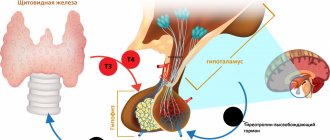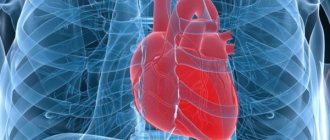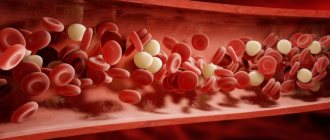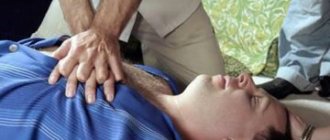What does “diffuse liver changes” mean?
Diffuse changes are not a separate disease, but a consequence of long-term pathological processes. The term is used when undergoing an ultrasound examination. During the examination, the diagnostician sees structural changes affecting the tissues of the organ.
With focal changes, a specific area suffers, and with diffuse changes, the entire organ at once.
According to the degree of manifestation, the violation is divided into 3 groups:
- moderate;
- minor;
- expressed.
Moderate diffuse changes occur with prolonged abuse of alcoholic beverages, large amounts of fatty foods in the diet and intoxication processes due to medications. Minor tissue changes are diagnosed in the early stages of diseases, with bacterial or viral inflammation.
The causes of pronounced changes are secondary or primary cancer tumors, cirrhosis, excess weight, diabetes mellitus or chronic hepatitis. The edematous organ increases in size several times, and functionality is impaired.
Changes in structure and structure are divided into 3 types:
- by type of fatty infiltration;
- by type of hepatosis;
- according to the type of steatosis.
The gland is involved in the process of nutrient metabolism. Under the influence of enzymes in the intestines, the breakdown of fats coming from food occurs. The liver converts them into triglycerides and cholesterol. With diffuse changes, they accumulate in the tissues of the organ, disrupting its activity.
A healthy gland is homogeneous, with a large number of bile ducts and blood vessels. With hepatic changes, excess fat accumulates inside the cells, leading to the gradual destruction of healthy hepatocytes.
With steatotic disorders, scattered fat accumulations appear in the liver. Because of this, healthy cells are destroyed, causing the formation of cysts. The result is pathological irreversible structural changes.
Pathogenesis
Diffuse changes in the pancreas are not an independent diagnosis, but evidence of the development of a pathological condition and its separate symptom. This symptom is not always accompanied by an underlying disease.
The pancreas is the largest endocrine and exocrine gland. It produces pancreatic juice, performing an exocrine function. The pancreatic tissues also contain endocrine glands that produce insulin . Parenchyma is the main component in the structure of the gland. If the biochemical balance is disturbed, destruction and replacement of its tissues can occur. Consequently, when parenchyma cells are replaced, the process of normal pancreatic functioning may gradually be disrupted.
With certain disorders in the gland, along with tissue density, the echo structure , that is, the ability to reflect sounds during an ultrasound examination. Consequently, this condition is interpreted not as a disease, but as a fact that is observed on ultrasound.
Reasons for the development of pathology
Diffuse changes can occur against the background of chronic diseases or under the influence of negative factors. In most cases, the process is irreversible, even if the patient begins treatment.
Diseases
During an ultrasound of the liver, diffuse changes are displayed in a number of diseases. The list includes:
- parasitic infestation;
- diabetes;
- advanced obesity;
- viral inflammation;
- hepatitis;
- neoplasms;
- cirrhosis.
With obesity and diabetes, there is more iron, and tissue echogenicity increases significantly. Viruses trigger the process of tissue degeneration, but after treatment the process stops and spontaneous restoration to physiological norm occurs.
Predisposing factors
Violations lead to:
- Frequent stress and overload
. Due to psycho-emotional problems, the production of adrenaline increases in the adrenal glands. The hormone is broken down by the liver, and its excessive amount leads to damage to hepatocytes. - Unhealthy eating
. Fatty and heavy foods create additional stress on the organ, which leads to rapid “wear and tear”. - Ecological situation
. Various toxic substances are transported to the liver through the bloodstream. Due to frequent overloads, the neutralization process is disrupted and the organ is gradually poisoned. Even life near major highways is dangerous. - Alcoholism
. Liver enzymes process ethyl alcohol, and it breaks down into aldehydes. They lead to the destruction of healthy areas of tissue, which are replaced by fatty patches. - Drug therapy
. Some medications contain substances with hepatotoxic effects. Violation of the dosage or too long treatment “kills” the liver.
With timely detection of the pathological process on ultrasound, the negative effect can be reversible.
Signs of diffuse changes
Symptoms of changes depend on the underlying disease.
Similar signs include:
- fragility of blood vessels;
- digestive problems;
- increased fatigue;
- constant weakness;
- changing the structure of the language;
- frequent mood swings;
- slight increase in temperature.
With liver problems, patients often complain of constant heartburn and nausea after eating. Feces change color, becoming whitish or almost black. Noticeable cracks appear on the surface of the tongue, and a white or yellowish dense coating is possible.
Sweating becomes more frequent, and an unpleasant, pungent odor appears, even soon after taking a shower. The condition of the skin worsens: it acquires a yellow tint, quickly dries and flakes. Acne and allergy symptoms are often observed. In the morning and after eating inappropriate foods, an unpleasant bitter taste remains in the mouth.
Important! If the liver parenchyma increases, nearby organs suffer. Due to pressure, pain occurs in the pancreas, spleen or gallbladder. There are no nerve endings in the liver itself and it rarely hurts, which is why patients seek help too late.
Possible manifestations
Diffuse changes in the structure of the pancreas can manifest themselves in different ways. If we talk about primary manifestations, we can distinguish the following symptoms:
- decreased appetite and, as a result, decreased body weight;
- nausea, belching, heartburn;
- intestinal disorders (manifested by constipation, diarrhea, bloating, etc.);
- feeling of heaviness in the epigastric region.
Unpleasant sensations in the epigastric region are the main sign of impaired pancreatic functionality
If the patient has pronounced diffuse changes, then the clinical picture is acute. That is, a person experiences constant nausea, diarrhea, pain, aversion to food, etc. In this case, the patient must be immediately hospitalized and provided with comprehensive treatment.
Diagnostics
The main diagnostic method is ultrasound examination, which reveals echographic signs of changes.
If necessary, additional research methods are prescribed.
| Type of study | Goals | What will show |
| Blood for hepatitis | Determines the presence of hepatitis, the level of pathogen activity, and the type of disease. | The presence or absence of specific antibodies to the virus. |
| Radionuclide scanning | Displaying the presence of echo signs of changes. | Based on the nature of the distribution of the contrast agent, specialists evaluate the echostructure of the liver tissue. It is also possible to identify post-traumatic changes or metastases. |
| Blood biochemistry | Assessment of the functional activity of hepatocytes. | Bilirubin and ALT increase, albumin levels become lower. |
| CT | Shows small tumors, helps determine the presence of parenchymal bleeding. | |
| Fine needle biopsy | Histological examination. | Carried out to confirm cancer. |
A healthy liver on ultrasound is homogeneous, with fine granularity, weakly intense echogenicity, and further decreases in the area where the vessels are located. With fatty hepatosis, an increase in the echo signal occurs over the entire area of the gland. The organ has rounded edges, hepatomegaly (increase in size) is noticeable.
The main sign of cirrhosis is a lumpy liver. False lobules appear due to connective tissue. The surface of the organ is heterogeneous and uneven, the tissues are compacted. Hepatocytes are uneven: one part atrophies, the other compensatory increases. The vascular pattern of the liver is enhanced.
Hypothyroidism
Hypothyroidism
– a state of deficiency of thyroid hormones in the human body.
Primary hypothyroidism
– hypothyroidism, which develops as a result of damage to the thyroid gland itself.
Subclinical hypothyroidism
- elevated TSH level with free T4 level within normal values.
Secondary hypothyroidism
– a clinical syndrome that develops as a result of insufficient production of TSH by the pituitary gland in the absence of primary pathology of the thyroid gland itself, which could lead to a decrease in its function.
Prevalence
Primary hypothyroidism is one of the most common endocrine diseases; a particularly high incidence is detected in iodine-deficient regions. The average prevalence is 4.6% of the population,
Clinic
The most common symptoms of hypothyroidism
: severe fatigue, drowsiness, dry skin, hair loss, slow speech, swelling of the face, fingers and toes, constipation, memory loss, decreased cognitive function, chilliness, hoarseness, depressed mood, uterine bleeding, infertility, depression, dementia, joint pain. Symptoms do not always appear all at the same time; often one group of symptoms predominates.
Upon external examination, patients with severe and long-term deficiency of thyroid hormones may have characteristic external manifestations: general and periorbital swelling, a puffy face with a pale icteric hue, and poor facial expressions.
Instrumental and laboratory research methods: to clarify the diagnosis, it is necessary to conduct an ultrasound of the thyroid gland, a study of the level of free thyroxine (FT4), thyroid-stimulating hormone (TSH), antibodies to thyroglobulin and thyroid peroxidase.
The diagnosis of hypothyroidism is established when TSH levels increase and free T4 decreases below normal.
Treatment
Replacement therapy is recommended for all patients diagnosed with overt hypothyroidism. The drug of choice for replacement therapy is levothyroxine sodium (L-thyroxine, Eutirox). The dose is selected by the doctor under the control of the level of free thyroxine (FT4) and thyroid-stimulating hormone (TSH).
Treatment
Therapy of diffuse changes requires an integrated approach, including:
- drug treatment;
- vitamin therapy;
- diet;
- rejection of bad habits.
The patient will have to regularly visit the doctor, take tests and undergo ultrasound examinations to monitor the results of treatment and the current condition of the organ.
Medicines
Medicines are selected individually, depending on the underlying disease, the patient’s age and the condition of the liver.
Therapy may include:
- Immunostimulants and antivirals (Cycloferon, Ribavirin). Increases the body's resistance and reduces the activity of hepatitis viruses.
- Plant hepatoprotectors (Silymarin, Gepabene, Karsil). Prescribed for toxic lesions, cholecystitis, cirrhosis. They protect the liver from harmful effects, stimulate the regeneration process, and stop the destruction of cell membranes.
- Amino acids (Heptor, Heptral). Accelerate the recovery of hepatocytes, have antioxidant and desontification effects.
- Preparations based on beef liver hydrolysates (Sirepar, Gepatosan). Protect the organ, cleanse the blood.
- Choleretic (Ursofalk, Odeston, Holemaks). Restores normal bile flow and relieves spasms.
- Phospholipids (Essliver, Essentiale Forte, Phosphogliv). Normalize metabolism in liver tissues.
The dosage and duration of the course are determined by the attending physician. Additionally, vitamin-mineral complexes and preparations are selected to restore the microflora of the gastrointestinal tract. During pregnancy, many of the drugs are contraindicated; therapy is carried out on an individual basis.
How to treat with folk remedies?
Traditional medicine recipes are used as aids. First make sure there are no contraindications for the ingredients used.
Olive oil
The oil helps cleanse the liver of toxins; it should be drunk in its pure form.
During the first 14 days, 0.5 tsp is enough. once a day. Afterwards the quantity increases to 1 tbsp. l. The maximum duration of the course is a month.
Drink with oats
Oats cleanse the blood, birch buds restore metabolism and correct high cholesterol levels. Lingonberries (both berries and leaves) relieve inflammation.
You will need:
- 3 cups dry oats;
- 3 tbsp. l. birch buds;
- 3 tbsp. l. lingonberry leaves.
Grind all the ingredients, pour in 3 liters of cold drinking water, leave in a dark, warm place for 24 hours. After the time has passed, place everything in an enamel bowl and place on low heat. When the broth boils, remove and cool the liquid. Drink 150 ml before meals for a month.
Decoction with honey
Natural honey helps renew tissues and increases glycogen in the liver. Cinnamon normalizes digestion, has a positive effect on the body's condition in diabetes, and helps cleanse the body of toxins and waste. Wormwood is used to combat pathological microorganisms.
The recipe includes:
- 1 tsp. chopped cinnamon;
- 1 tsp. wormwood;
- 200 ml water;
- 300 g honey.
Pour water over wormwood and cinnamon and bring to a boil over low heat. Add natural honey, cook until the mixture becomes thick. Drink 1 tsp. during meals 3 times a day. The course lasts 3-4 weeks. Store the finished product in the refrigerator.
Corn silk tea
Corn “hairs” help control blood sugar, neutralize toxins, restore metabolism, and improve liver and pancreas function.
For tea you will need:
- 300 g corn silk;
- 3 liters of hot water.
Pour boiling water over the hairs and leave for a day. It is recommended to store the liquid in a thermos. Drink 150-200 ml in the morning and evening. The duration of use is not limited.
Rose hip decoction
Due to its vitamin composition, rosehip supports the immune system. Phytoncides and mineral components have choleretic and diuretic effects, due to which they help alleviate the condition of pathologies of the kidneys, gall bladder and liver.
Prepare for the decoction:
- 200 g rose hips;
- 1 liter of hot water.
Grind the fruits with a blender and add hot water. Boil the mixture over low heat for 10 minutes. Pour the finished broth into a thermos and let it brew for 12-15 hours. You need to drink the entire amount within 5 days; store the leftovers in the refrigerator. Take a decoction of 150 ml per 30 minutes. before meals, no more than 4 times a day. The duration of the course is 10 days.
Diet
{banner_banstat9}
If liver activity is impaired, “heavy” foods that create extra stress are excluded from the diet. Steam, boil or bake food. Frying (especially using oil or animal fat) is removed.
The following products will have to be removed from the menu:
- canned food;
- mushrooms;
- fatty fish;
- smoked meats;
- pickles;
- sausages;
- salo;
- fatty meats;
- legumes
It is strictly forbidden to drink alcohol in any quantity. It is also recommended to give up strong tea and coffee, and carbonated drinks.
It is allowed to eat a small amount of white bread, but it will have to be dried first. The basis of the diet should be cereals, lean meat, lean vegetable soups, fruits and vegetables. Kefir, milk, cheeses and sour cream - only with a low percentage of fat content.
Surgical intervention
{banner_banstat10}
If conservative treatment methods do not bring results, surgical intervention is recommended. It consists of partial or complete removal of the liver and other affected internal organs.
The operation is necessary when:
- advanced hepatitis;
- severe cirrhosis;
- cysts;
- large neoplasms;
- portal hypertension;
- cancer metastases.
In case of complete removal, the patient needs a liver transplant.
Possible consequences and complications
Even minor diffuse changes can lead to the formation of chronic pathologies.
These include:
- infertility;
- encephalopathy;
- malabsorption syndrome;
- ascites;
- liver failure;
- extensive internal hemorrhages.
With timely initiation of treatment, the prognosis is quite favorable and the functioning of the organ can be restored in full.
List of sources
- Gubergrits N. B., Linevskaya K. Yu., Belyaeva N. V. Differential diagnosis in gastroenterology. From symptom and syndrome to diagnosis and treatment: practical work. hands - Kyiv: Trush E. N. [ed.], 2021. - 623 p.
- Danilov M.V., Fedorov V.D. Pancreatic surgery. Guide for doctors. M.:b Medicine, 1995. 312 p.
- Zakharova O.P., Egorov V.I., Karmazanovsky G.G. Surgical treatment of pancreatic tumors: computed tomographic criteria for resectability. Annals of surgical hepatology. 2011. 16. No. 1. pp. 84-91.
- Zimmerman Ya.S. Chronic pancreatitis // Bulletin of the Pancreatology Club. - 2009. No. 1. - P. 38-47.
Prevention
A healthy lifestyle, proper nutrition and avoidance of alcoholic beverages will help you avoid liver problems. To minimize the risk of hepatitis B, vaccination is necessary. At the first suspicion of organ pathology, seek help from a doctor. Doctors also recommend regularly (at least once a year) diagnostic ultrasound of the abdominal organs: this will allow timely detection of developing disorders.
The liver is a large and hardy organ. With local dystrophic changes, a compensatory process is triggered: the gland increases in size to help the body survive. The appearance of alarming symptoms indicates serious problems that require specialist intervention.
General information
Often, when examining the gastrointestinal tract in patients, diffuse changes in the pancreatic parenchyma . Receiving such a conclusion, a person often does not understand what such a diagnosis means and whether it is necessary to take any measures to treat it. According to experts, diffuse changes in the pancreatic parenchyma indicate that the body already has prerequisites for the development of pancreatitis .
Therefore, already at the stage of receiving such a diagnosis, the patient should reconsider his lifestyle in general and his diet in particular. Most often, such changes are diagnosed in elderly people, as well as in those who suffer from pancreatitis , diabetes , liver dysfunction, and digestive tract organs. Pathology can develop as a consequence of infectious and inflammatory diseases of internal organs, in which there is a violation of metabolic processes in the body.
This article will discuss what such a diagnosis means, how this pathology manifests itself, and what treatment methods should be practiced.










